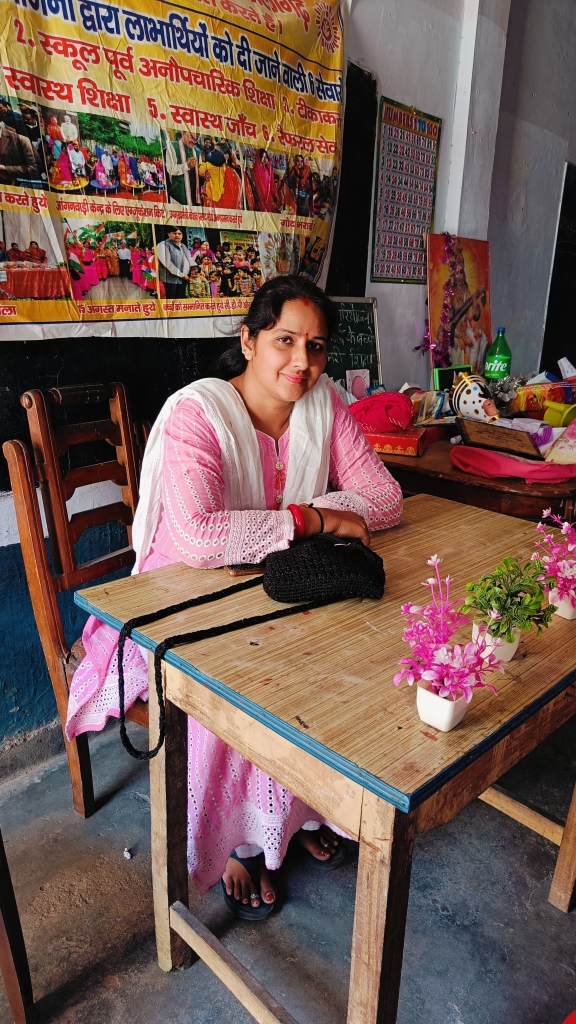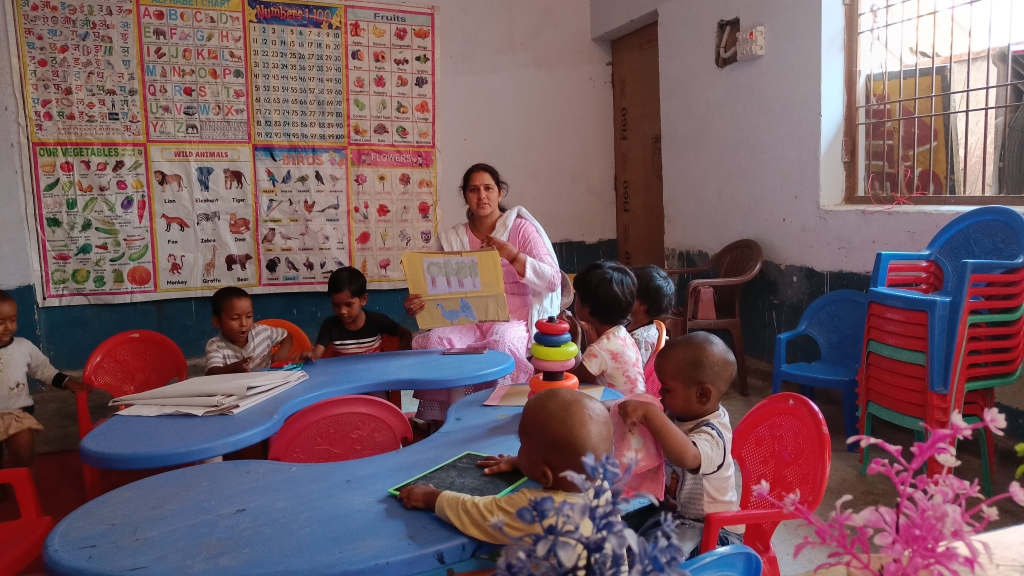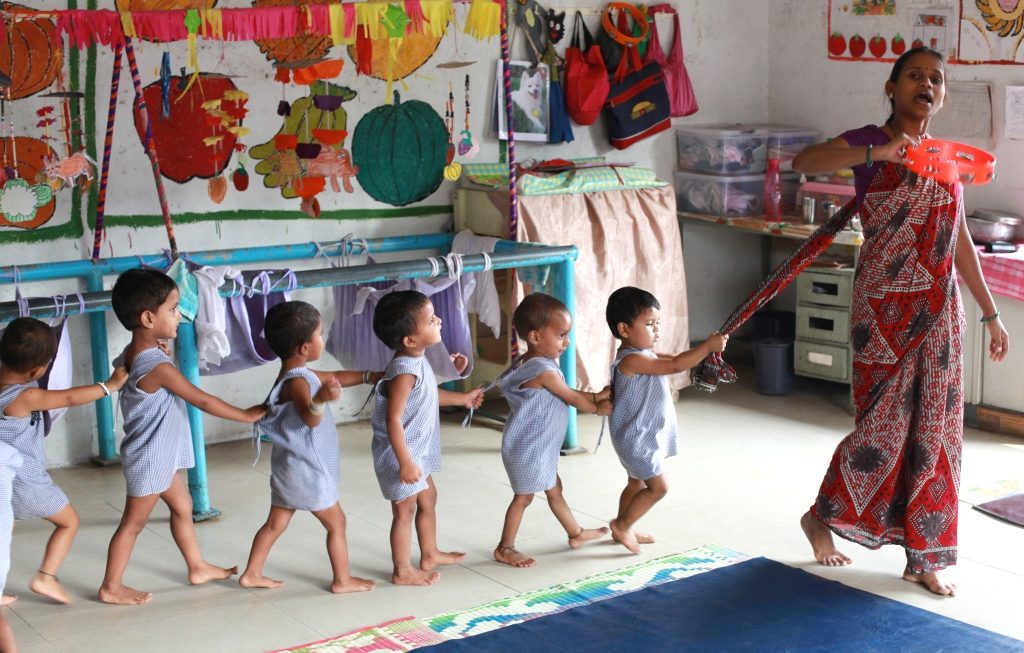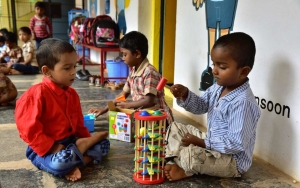Nidhi Sharma, an Anganwadi worker with 17 years of experience, currently serves at the Kishanpur 4 Anganwadi centre in the Aligarh district of Uttar Pradesh.
In our conversation with Nidhi, she shares insights into the day-to-day work of an Anganwadi worker, highlighting their roles and responsibilities, day-to-day challenges and their perspectives on the work they do. We also talk about the recent pilot intervention of CSF’s 12-week school readiness programme in Aligarh, which was implemented to support early childhood education in 50 Anganwadi centres in five blocks of the district from February to May, 2024. Through Nidhi’s account, we aim to shed light on the practical aspects of implementing early childhood education programmes and the role of Anganwadi workers in facilitating it.

Anganwadi Worker, Aligarh,
Uttar Pradesh
Q1. What motivated you to pursue a career as an Anganwadi worker and how has your journey been so far?.
I started as an Anganwadi worker in 2007 and it has been 17 years since then. I completed my graduation and my post-graduation after getting married. Even before this, I used to teach children, and I thought this role would give me an opportunity to continue it in the coming years. Even though my family (in-laws) were not in favour of me working, I managed to convince them by reassuring them that my career would not impact my personal life.
The fact that I have a bond with the children that goes beyond a teacher-student relationship brings me the most joy. Even before entering the classroom, my children start sharing their stories about their life and families – it is very rewarding!
Q2. Can you walk us through a typical day for you as an Anganwadi worker? What are some of your core roles and responsibilities?
As an Anganwadi worker, my job starts with preparing for my class prior to teaching. For this, I prepare the lesson plan a day in advance and gather the materials and resources to be used for the lesson before class, ensuring that no time is wasted in thinking or preparing during the session. However, there are times when we need to adjust and be flexible in terms of adhering to our schedule, depending on the children’s mood, but it helps us to a great extent. For instance, if we planned to teach them the alphabet but children wanted to hear stories or play a game, we adapt and teach accordingly.
At the beginning of the class, children often share things with us that mean the most to them, such as, “My aunt came to my house today” or “My mother scolded me because I did this”. This serves as a great bonding experience. We ensure to listen to them first and then gradually transition into actual teaching. Once done, I end the day with a poem, story, or some playful activity to end the session on a high and happy note.
In addition to teaching, we are responsible for looking after children’s health, working with pregnant women and lactating mothers, ensuring that they are registered with us and receiving vaccinations regularly and ensuring timely vaccinations and regular measurements of height and weight for new-borns. We are also assigned responsibilities as Booth Level Officers (BLO) during elections and participate in Tuberculosis and Leprosy-related surveys, among other tasks. Many duties related to the health department are regularly assigned to us.
Q3. With multiple responsibilities to manage, how do you ensure that you have adequate time for teaching? Do you ever feel constrained by resources, time and/or other factors?
If we are supposed to teach for 2 to 2.5 hours, we reduce that teaching time to an hour or so on days when we have additional work. However, we make it a point to teach regularly because any breaks between classes can cause a learning gap, as children tend to forget what was previously taught. Sometimes, we need to put in extra hours to ensure that does not happen. It is not possible to complete all our responsibilities within the limited time so we work extra hours to finish and manage all our work.
In terms of resources, we do face limitations at times. It has been a while since we last received teaching and learning materials (TLM) for the classroom. Occasionally, we also pay out of our pockets to purchase necessary materials or we create them ourselves.
Additionally, I also find teaching three to four-year-olds relatively challenging. While the older children are able to follow instructions, the younger ones cannot understand them and require more attention. When teaching children of different age groups, it becomes difficult to cater to all groups simultaneously without assistance; not having a Sahayika (helper) significantly adds to my workload.
While we receive two to three training sessions every year from the department, I do think more frequent sessions on different teaching methods could be beneficial for us.
Q4. How did your experience with the 12-week school readiness material compare to earlier resources like Pahal/52-week calendar? Did it make classroom teaching and management easier for you? If so, in what ways?
There are many differences between the two manuals: Pahal and the 12-week manual. Pahal was a very thick book, making it difficult for us to understand where and how to start the lessons. In contrast, the 12-week manual presents everything on a single page. It outlines the teaching and learning materials needed for the entire day, especially those easily available in our surroundings, so we did not have to purchase anything. By reviewing the page one day in advance, we could prepare efficiently for the entire upcoming lesson.
The 12-week manual has been particularly helpful in mapping out our lesson plans. In the past, we did not plan for the entire day, instead we would go to the centre and teach random topics. However, with the manual, we have to spend just ten minutes reading and planning for the next day.
The designated time slots for different sections ensure that the children remain engaged and do not get bored in class. Earlier, the topics we taught were not connected to one another, making it difficult for children to establish proper understanding of the topic. With the manual, however, the topics are interrelated. These elements have significantly improved our time management in the classroom.
Q5. What do you feel are your greatest achievements as an Anganwadi worker?
To elaborate on this, I would like to share two stories with you.
The first is about a girl whom I cared for since her birth, attending to her vaccinations and nutrition. Later, she enroled in my centre and proved to be a very bright student. However, at the age of four, she was diagnosed with a hole in her heart. Unfortunately, her parents were unable to afford the necessary treatment due to financial constraints. I put in all my efforts to get their Ayushman card issued, which enabled her to receive the treatment she needed. She is doing well now and her parents always credit me for her recovery.
The second instance involves an elderly lady in the locality whose children had abandoned her. Once I learned about her situation, I took the necessary steps to help her obtain a pension under a government scheme. Now, whenever I meet her, she tries to touch my feet and expresses her gratitude for assisting her in receiving the pension. Such things really make me feel proud and reassure me for having done something good and right.
Q6. What are your hopes for the future of your students and what role do you see yourself playing in this journey?
I feel that not every child is made for academics. Every child has an aptitude for different things and they should be encouraged to work on them. Apart from academics, I try to work with them based on their interests. For instance, there was a boy in my class who was interested in Mehendi (Henna) designs. He was always interested in drawing, over learning alphabets in the classroom. I taught him how to draw flowers, leaves, peacocks, hands, etc. Today, he has opened a parlour and earns his living as a Mehendi artist .

I also hope they all become good human beings. Their behaviour with the people around them depends on the way I behave around them at the centre. I ensure to never use impolite language or behaviour, so they also follow the same and learn good values, along with and beyond academics.



